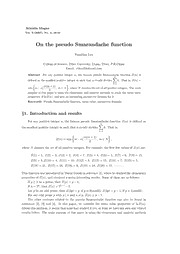Table Of ContentScientia Magna
Vol. 3 (2007), No. 4, 48-50
On the pseudo Smarandache function
Yuanbing Lou
College of Science, Tibet University, Lhasa, Tibet, P.R.China
Email: [email protected]
Abstract For any positive integer n, the famous pseudo Smarandache function Z(n) is
(cid:88)m
defined as the smallest positive integer m such that n evenly divides k. That is, Z(n)=
(cid:189) (cid:190) k=1
(cid:175)m(m+1)
min m: n(cid:175) , m∈N ,whereN denotesthesetofallpositiveintegers. Themain
2
purpose of this paper is using the elementary and analytic methods to study the mean value
properties of lnZ(n), and give an interesting asymptotic formula for it.
Keywords Pseudo Smarandache function, mean value, asymptotic formula.
§1. Introduction and results
For any positive integer n, the famous pseudo Smarandache function Z(n) is defined as
(cid:88)m
the smallest positive integer m such that n evenly divides k. That is,
k=1
(cid:189) (cid:190)
(cid:175)m(m+1)
Z(n)=min m: n(cid:175) , m∈N ,
2
where N denotes the set of all positive integers. For example, the first few values of Z(n) are:
Z(1)=1, Z(2)=3, Z(3)=2, Z(4)=7, Z(5)=4, Z(6)=3, Z(7)=6, Z(8)=15,
Z(9)=8,Z(10)=4, Z(11)=10, Z(12)=8, Z(13)=12, Z(14)=7, Z(15)=5,
Z(16)=31, Z(17)=16, Z(18)=8, Z(19)=18, Z(20)=15, ······ .
ThisfunctionwasintroducedbyDavidGorskiinreference[1],wherehestudiedtheelementary
properties of Z(n), and obtained a series interesting results. Some of them are as follows:
If p≥2 be a prime, then Z(p)=p−1;
If n=2k, then Z(n)=2k+1−1.
Let p be an odd prime, then Z(2p)=p, if p≡3(mod4); Z(2p)=p−1, if p≡1(mod4).
For any odd prime p with p | n and n(cid:54)=p, Z(n)≥p−1.
The other contents related to the pseudo Smarandache function can also be found in
references [2], [3] and [4]. In this paper, we consider the mean value properties of lnZ(n).
Aboutthisproblem,itseemsthatnonehadstudiedityet,atleastwehavenotseenanyrelated
results before. The main purpose of this paper is using the elementary and analytic methods
Vol. 3 OnthepseudoSmarandachefunction 49
study this problem, and give an interesting asymptotic formula for it. That is, we shall prove
the following conclusion:
Theorem. For any real number x>1, we have the asymptotic formula
(cid:88)
lnZ(n)=xlnx+O(x).
n≤x
Whether there exists an asymptotic formula for the mean value
(cid:88) (cid:88) 1
Z(n) or
Z(n)
n≤x n≤x
are two open problems.
§2. Proof of the theorem
Inthissection,weshallcompletetheproofofTheorem. Firstweneedthefollowingsimple
conclusion:
Lemma. For all real number x>1, we have the asymptotic formula
(cid:88) lnp
=lnx+O(1),
p
p≤x
(cid:88)
where denotes the summation over all prime p with 2≤p≤x.
p≤x
Proof. See Theorem 4.10 of reference [5].
UsingthisLemmawecanproveourTheoremeasily. Infactforanypositiveintegern>1,
(cid:175) 2n(2n−1)
note that n (cid:175) , from the definition of Z(n) we know that Z(n)≤2n−1. So by the
2
Euler’s summation formula we can get
(cid:88) (cid:88)
lnZ(n)≤ ln(2n−1)≤xlnx+O(x). (1)
n≤x n≤x
Now let A denotes the set of all square-full numbers n (That is, if p | n, then p2 | n) in the
interval [1, x]. Then we have
(cid:88) (cid:88) (cid:88)
lnZ(n)= lnZ(n)+ lnZ(n). (2)
n≤x n≤x n≤x
n∈A n∈/A
From reference [6] we know that
(cid:88) ζ(3) ζ(2) (cid:179) (cid:179) (cid:180)(cid:180)
1= 2 x12 + 3 x13 +O x16 exp −Clog35 x(loglogx)−15 ,
ζ(3) ζ(2)
n≤x
n∈A
where C >0 is a constant. By this estimate and note that lnZ(n)≤ln(2n), we may get
(cid:88) √
lnZ(n)(cid:191) x·lnx. (3)
n≤x
n∈A
50 YuanbingLou No. 4
Ifn∈/ A,thenn=1orthereexistsatleastoneprimepwithp|nandp2 † n. SofromLemma
we have
(cid:88) (cid:88) (cid:88) (cid:88)
lnZ(n) = lnZ(np)≥ ln(p−1)
n≤x np≤x p≤x n≤x
p
n∈/A (n, p)=1 (n, p)=1
(cid:183) (cid:184)
(cid:88) x x
= − +O(1) ·ln(p−1)
p p2
p≤x
(cid:88) lnp (cid:88) lnp
= x· −x· +O(x)
p p2
p≤x p≤x
= x·lnx+O(x). (4)
Combining (1), (2), (3) and (4) we may immediately get the asymptotic formula
(cid:88)
lnZ(n)=xlnx+O(x).
n≤x
This completes the proof of Theorem.
References
[1] David Gorski, The pseudo Smarandache function, Smarandache Notions Journal, 13
(2002), 140-149.
[2] F. Smarandache, Only Problems, Not Solutions, Chicago, Xiquan Publishing House,
1993.
[3] Kenichiro Kashihara, Comments and topics on Smarandache notions and problems,
Erhus University Press, USA, 1996.
[4] Liu Yanni, On the Smarandache Pseudo Number Sequence, Chinese Quarterly Journal
of Mathematics, 10(2006), No. 4, 42-59.
[5] Tom M. Apostol, Introduction to analytical number theory, Spring-Verlag, New York,
1976.
[6] Aledsandar Ivi´c, The Riemann zeta-function theory, New York, 1985, 407-413.
[7] Zhang Wenpeng, The elementary number theory, Shaanxi Normal University Press,
Xi’an, 2007.
[8]PanChengdongandPanChengbiao,Theelementaryproofoftheprimetheorem,Shang-
hai Science and Technology Press, Shanghai, 1988.

